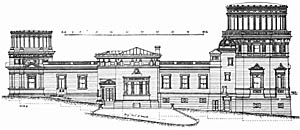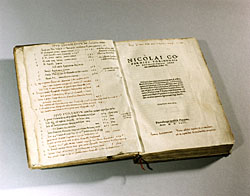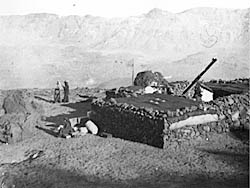ROE Heritage and the Crawford Collection
The Royal Observatory, Edinburgh, is an internationally recognised institution within the world of astronomical observation. Cultures throughout history have studied the heavens, seeking answers both to practical matters of agriculture and navigation and to the more profound existential questions. Since the 15th century, the tradition of the European observatory housing large telescopes has left a distinctive legacy of architecture and engineering. Gathering and analysing evidence from the far regions of the universe, these observatories have fed the spirit of scientific enquiry that has been reshaping our culture, from the Renaissance onwards.
In 1888, the 26th Earl of Crawford's generous gift to the nation of his internationally outstanding collection of astronomical books and instruments provided the impetus for the construction of the bold Italianate Royal Observatory building on Blackford Hill, two miles south of the centre of Edinburgh. In the course of the following century, the Observatory developed its reputation as a world leader in astronomy, steadily building up an archive of its work, including the records relating to the two greatest Astronomers Royal for Scotland, Thomas Henderson and Charles Piazzi Smyth. Today, the A-listed Observatory Building in its walled site - still at the forefront of astronomical science – is surrounded by open space and a nature reserve, with magnificent views of the city of Edinburgh to the north and the Pentland Hills Regional Park to the south.
There are, therefore, four main strands to the heritage of the Royal Observatory, linked by the tradition of scientific and educational activity on Blackford Hill:
- Observatory building and telescopes
- Crawford Collection
- Archives
- Scientific instruments
Observatory Building and Telescopes
Observatories are specialist and distinctive structures. The Royal Observatory, Edinburgh is an example of the confident Victorian approach to a highly specialised type of building and is a notable feature of Edinburgh's southern skyline:
Hermann Bruck, Astronomer Royal for Scotland, 1957-1975
The Observatory building, 180 feet long, is oriented east to west with octagonal towers at each end surmounted by cylindrical telescope housings. Ralph Copeland, the then Astronomer Royal for Scotland, chose the cylindrical drum form of covering in preference to the more usual hemispherical shape of dome because he considered it better suited to the Scottish climate. The housings are covered with sheets of green, weathered copper which blend beautifully with the red sandstone masonry. The exterior decoration is replete with astronomical references.
Between the two towers is a flat roof designed for smaller instruments and, originally, for instruction of students. The interior was most carefully planned to contain every possible facility for astronomy. These included laboratories, offices and a beautiful library in the South wing.
The East Tower is a fine example of the structure required for a telescope, including its revolving dome (with retracting section) and the central support structure. It echoes the engineering eloquence of a lighthouse, combining a specialised structure with high performance technology. The East Tower contains the 36 inch telescope, manufactured by Grubb & Parsons, which when installed in 1930 was the largest telescope in Britain. The West Tower houses the Schmidt telescope, completed in 1969. These two telescopes are associated with two of the Observatory's main areas of work during the 20th century, spectroscopy and wide-field astronomy.
The original buildings within the site's sandstone wall included the Astronomer Royal's house and the lodge. Although buildings have been added over time the campus still evokes a great sense of community among scientists and students. Beyond the boundary wall, Blackford Hill is an important open space on the south side of Edinburgh, including a nature reserve, the Braid Burn, the Hermitage historic house and the archaeological remains of an Iron Age fort. Historically, the site has a central place in the story of astronomy in Scotland and the UK: a working Observatory that was also home to the Astronomer Royal for Scotland, its remarkable setting an inspiration to observational scientists.
Crawford Collection
The Crawford Collection of books is the founding collection of the ROE on Blackford Hill, gifted by the 26th Earl of Crawford. It is of outstanding international significance and has been acknowledged as one of "four truly great collections of astronomical books" in the world.
The Collection contains some 15,000 items. The oldest printed books in the collection, by Nuremburg astronomer Johannes Regiomontanus, date from the 1470s. Perhaps more significantly, the collection contains a first edition of the greatest astronomical book of the 16th century, Nicolas Copernicus' De Revolutionibus. The copy is annotated by Erasmus Reinholdus, Professor of Astronomy at Wittenburg, providing an insight into how Copernicus' cosmological claims were received. It has been called the most important copy of the book in existence: a book that changed the perception of the place of earth, and so humanity itself, within the universe.
Archives
The archives consist of four sets of material:
- Observatory Archives
- Henderson Material
- Piazzi Smyth Collection
- Royal Observatory Edinburgh Plate Collection
The Observatory Archives contain correspondence, scientific and administrative papers and notebooks dating from 1764-1937. Of particular interest within the observatory Archives is the Henderson Material relating to Thomas Henderson, the first Astronomer Royal for Scotland. Henderson was the first person to measure the distance of a star, by observing its annual "parallax" or oscillation in the sky. The star he measured, Alpha Centauri, is now known to be the nearest star, but even so is 4.5 light-years distant. This achievement finally confirmed the Copernican theory, and showed mankind the immense scale of the Universe. It elevated Henderson to international status amongst astronomers. However, the historical material, including one of the earliest known daguerrotypes, as well as letters and notebooks, has not been properly researched.
In addition, the Observatory Archives contain the Piazzi Smyth Collection of sketches, photographs and manuscripts. Charles Piazzi Smyth (1819-1900) is the most colourful of the Astronomers Royal for Scotland. He was the first astronomer to appreciate the value of clear, vapourless skies for observing. This led him to experiment with 'mountain top'; observing in Tenerife, a methodology that has since led to the establishment of modern observatories in locations such as Hawaii and Chile and, most recently, to space observatories such as the Hubble Space Telescope. Piazzi Smyth also made ground breaking advances in stereo photography. Ian McGowan, Librarian, National Library of Scotland, has described this material as "of the first importance for the history of photography as well as astronomy". The Piazzi Smyth archives are owned by the Royal Society of Edinburgh and have been deposited at the Observatory's library on long term loan.
Scientific Instruments
In general terms, telescope design and instrumentation have been critical to the history of astronomy. Indeed, this relationship remains the basis for the co-location of the IfA and the UK ATC on Blackford Hill. Since the 1950s, the ROE has regularly transferred redundant instruments to the National Museums of Scotland for safe-keeping and display.




